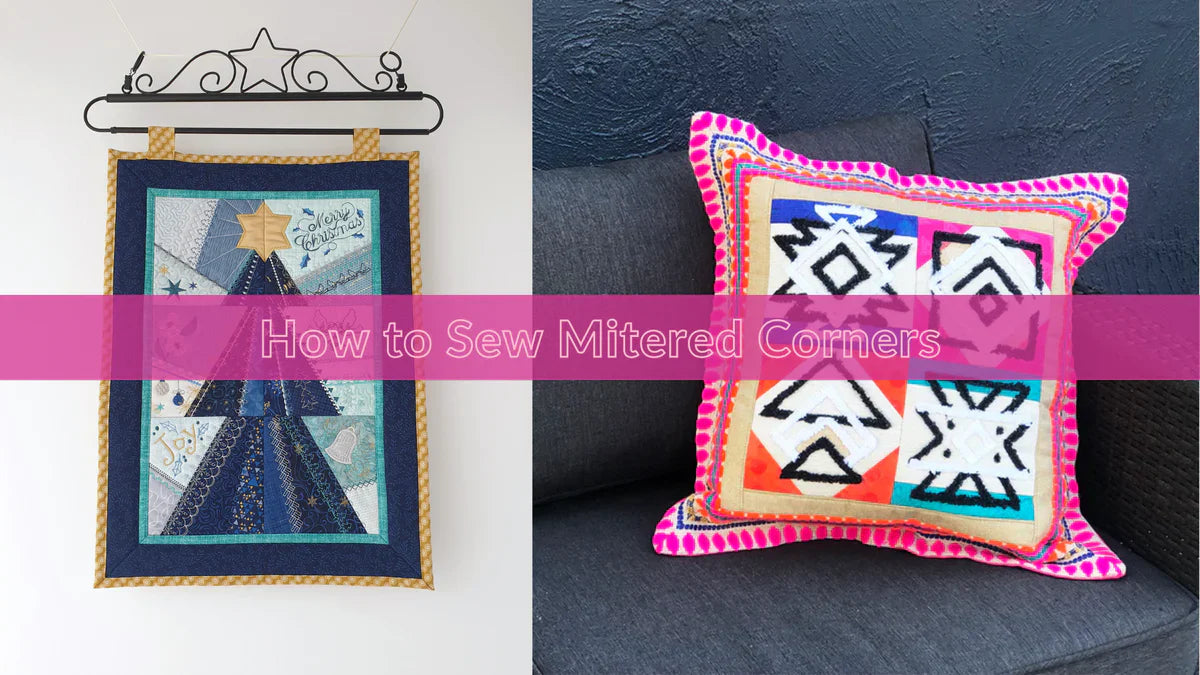Once you have all of your appliquéd pieces pinned, fused or glued in place, get a thread to match or contrast your design and let's get started.
If you want your stitching to be a feature, use a contrasting thread instead of a matching thread. Alternatively if you would like your stitching to blend into your appliqué use a thread as closely matching to your fabrics as possible.
We're demonstrating with some simple shapes to allow you to practise on a variety of lines to work with.
Doing a test piece like this gives you the opportunity to practice keeping your stitches straight, try different lengths and widths, threads and needles before you start a project.
That way you can see which you like the most.
We have selected a circle, square and triangle as test appliqué as these will cover the various techniques your need for learning appliqué.
When you are ready to dive into a new project, we have lots of great appliqué and sewing patterns for you to try.
Round Appliqué
Find a good starting point on your appliqué and get to stitching. Tie off the stitches and slowly make your way around the edge of your appliqué.
If like us you are starting with your round edge, it is important to keep your appliqué bar (the one that goes across and over the appliqué fabric) as square to the edge as possible.
Taking little steps every now and again, with each stitch, lifting the foot and turning your work it will look like your foot is square to the edge of the appliqué and not sloping or slanting as you stitch.
The idea is that the needle caresses the raw edge of the appliqué, as we are working with raw edge appliqué, and then to stitch with the bar going across to cover and support the appliqué while being stitched onto the base fabric.
We are using a double pass, appliqué stitch in our example.
This is three stitches along the edge of the appliqué and then one across as a bar (onto the appliqué) as opposed to a true blanket stitch which is a single stitch on the edge of the appliqué and then a single bar onto the appliqué.
Take your time when learning to stitch around your curved appliqué, they're always a little slower than straight appliqué.
It's good to take these curves slowly as you want the bar of the appliqué to sit as neatly and as squarely to your appliqué as possible.
When you've finished your curved appliqué just lock off your stitch and you're done.
Squared Corners on Appliqué
We highly recommend cutting a little square of appliqué to practice your corners if you're not confident.
Or like us you can do a variety of shapes on the one backing fabric.
Start off by locking off your stitches and then stitch down the length of your appliqué. Keep your foot over the appliqué and your needle hugged right up to the raw edge of your appliqué.
Doing these straight lines is much faster than the curved edge, so you will be able to get these done a little faster.
The tricky part is when you reach your corners. Once you come close to the corner of your square, slow up, and try and eyeball (calculate) how many stitches you will need until you reach the edge of your appliqué.
Ideally your stitch will end right in the corner of the appliqué. If not just get as close to that as you're able.
Once you have hit the corner of your appliqué, leave the needle down and then turn your project.
In our example, once we are at the corner, have the needle down and have rotated our appliqué, we pull the fabric a little to the left hand side and stitch. This ensure that the stitch forms exactly on that corner to give it a perfect placement.
There is no right or wrong way of doing your corners. If one stitch is closer to the other when coming to your corners, that is absolutely fine.
You're able to manipulate the fabric by pinching a little, or pulling a little, to extend or shorten those stitches to ensure they make the corners just so.
However, as we said if they are a little longer or shorter, just start again and work the appliqué samples until you really get the hang of it.
Points on Appliqué
Starting at our point of the triangle, lock of your stitches and then make your way down the straight edge of your appliqué to the next point.
We are going to come down to the point and pivot, in two sections.
When you get close to the point, slow down and try (like the square) to get as close as you can to that point.
Sink your needle into the appliqué at the point and turn your appliqué.
If you need to pinch or pull your fabric slightly to ensure that you're right at the end of the point. Make your corner stitch and straighten up your fabric and make your way back down the straight edge of your appliqué.
This should give you a triangle at the top of your appliqué, which is what you want.
The idea for this stitch is to try and keep it as square to your appliqué as possible.
Take your time in moving along your shapes. Each of these techniques takes time to master.
This is a relaxing and fun stitch to use for raw appliqué. We hope you enjoyed this blog.
If you have any questions or would like to know more we have some great online Sewing and Appliqué groups you can join as well as lots of great video tutorials and blogs.






Leave a comment
All comments are moderated before being published.
This site is protected by hCaptcha and the hCaptcha Privacy Policy and Terms of Service apply.